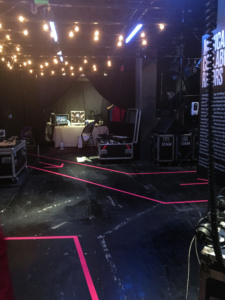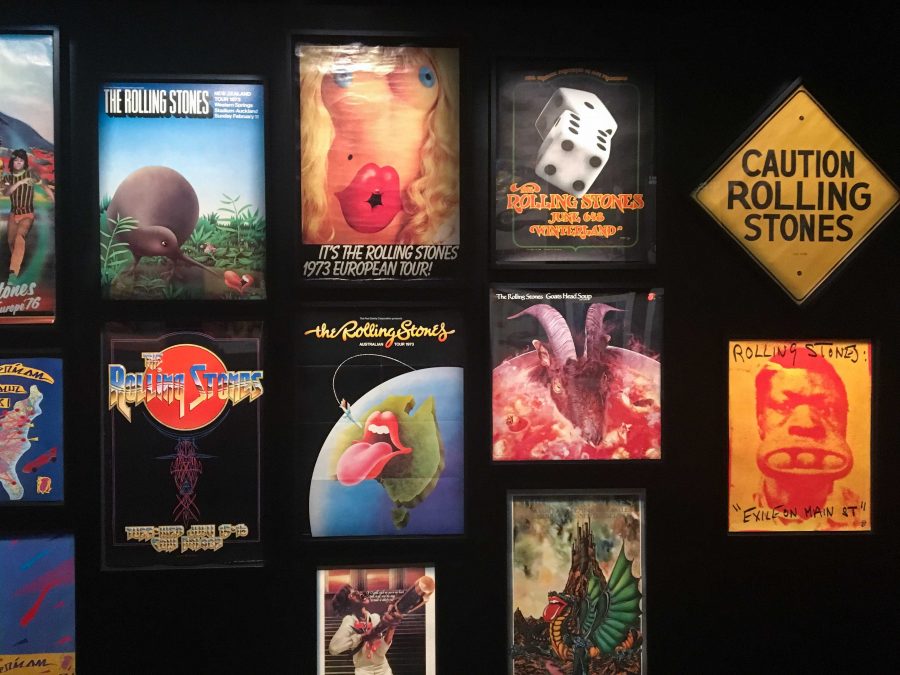If you have yet to find the time to go to the Nashville Musicians Hall of Fame and Museum, the Rolling Stones exhibit is the excuse you’ve been waiting for.
Recently, brightly patterned statues in the shape of the Stones’ iconic tongue logo may have caught your eye while driving downtown. These statues are promoting the touring Rolling Stones exhibit, which is making its last stop in Nashville before heading overseas. Last weekend, I had the chance to visit the exhibit, and it was truly interactive, engaging and aesthetically-pleasing on top of being fun.
Upon entering the exhibit, I was immersed in a room washed with red light. Moving timelines and maps depicting the Stones’ many album releases and accompanying tours were projected on the wall. It was a suspenseful atmosphere, complete with the wall-sized sign beckoning “Ladies and Gentlemen.”
As I entered the next room, I was blinded in the darkness. Suddenly, a collage of screens blared to life, bombarding me with a mosaic of sounds and images. Rolling Stones’ classics faded in and out as the screens showed screaming fans, news headlines, live performances and behind-the-scenes moments. The film carried me through the decades, beginning with black and white images before transitioning to psychedelic flourishes of color. The dynamic, borderline chaotic form of the film captured the explosive nature of the Stones’ rise to fame.
The next portions of the exhibit offered an assortment of documents including vintage photographs, handwritten diary pages and posters advertising shows of the past. This room also featured a video tracing the Stones’ first interaction with blues music at Chess Records.

Following this room was a replica of the band’s Edith Grove flat, where they lived before their first big tour in 1963. In a quote displayed on the wall, Mick Jagger recalls, “It actually wasn’t a bad space…it’s what we did with it that was disgusting.” And with that, I entered into a space dirtier than any frat house or dorm room on campus. Littered with fake dirty dishes, swathed in grungy carpeting and drowning in imitation cigarette butts, this was the glamorous existence of a rock ‘n’ roll band. The exhibit is highly experiential; next I viewed a re-creation of a recording studio at Pathé Marconi Studios, where the Rolling Stones recorded many of their most recognized songs.
The next portion of the exhibit stands out because the band’s guitarist Ronnie Wood visited about a week ago to return a guitar fresh from the recording studio to its glass case. This room gave visitors a taste of the music-making process. I was even able to choose a Stones’ song and remix the instruments and vocals.
Moving beyond the making of the music, the exhibit turned to the art of the Rolling Stones. First, I traced the making of the defiant tongue logo, and then saw the album cover design process. Instead of digital files, I was confronted with cut and layered sheets of paper.
Another aspect of popular music that I take for granted is the elaborate stage designs. The Stones were committed to using any means possible to enhance their performances and put on a great show. In the next room, a short film screening showed another medium that the Stones pioneered: the live concert documentary.
Following this display was my favorite part of the exhibit, simply titled “Style.” This room featured dozens of mannequins dressed in the best of the Rolling Stones’ stage fashions. Knowing their rebellious reputation, I laughed at the clean-cut matching blazers that constituted the Stones’ first costumes. The rest of the room was filled with suede pants, embroidered leather jackets, Elvis-inspired jumpsuits and leopard printed ensembles. An entire wall was dedicated to Mick Jagger’s various “Sympathy for the Devil” costumes.
The exhibit ended with a sensory-overload 3D video montage of Rolling Stones concert footage, featuring Mick Jagger strutting down the catwalk and seemingly out of the screen. Exiting the movie, I found myself in a replica of a concert venue backstage area. As I exited the exhibit, I imagined how Keith Richards would be confronted with the same scene after playing a sold out show.
Leaving the exhibit, I gained a new level of respect for the Stones. I have long been a fan of their music, but this exhibit displayed how they pioneered the music industry as a multimedia, multifaceted, multibillion dollar business. Film, costume, stage design and art are now the standard that every artist must meet. Having lived in Nashville for almost eight months now, this exhibit marks the first time I’ve felt like I truly arrived in Music City.
Tickets can be purchased at the door, and the museum is offering a student discount with a valid student ID.

